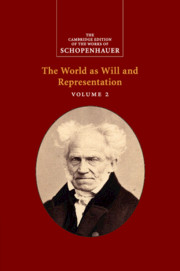Chapter 36 - Isolated Remarks on the Aesthetics of the Visual Arts
Published online by Cambridge University Press: 30 June 2022
Summary
Beauty and grace are of the greatest importance in sculpture, while in painting, expression, passion and character predominate, and to this extent must not be included among the required elements of beauty. A complete beauty of all forms, such as sculpture requires, would curtail what is characteristic and tire us with its monotony. This is why painting can also depict ugly faces and emaciated figures: sculpture on the other hand demands beauty, even if it does not always demand perfect beauty, although certainly force and fullness of the figures. Consequently, an emaciated Christ on the cross, a dying St Hieronymus consumed by age and infirmity, as in Domenichino's masterpiece, are suitable subjects for painting: by contrast, Donatello's marble John the Baptist in the Florence gallery is repulsive in spite of its masterly execution because fasting has reduced him to skin and bones. From this point of view, sculpture seems suited for affirming the will to life and painting for negating it, which could explain why sculpture was the art of the ancients and painting the art of the Christian age. –
In conjunction with the argument in § 45 of the First Volume that the discovery, recognition, and determination of the types of human beauty is based on a certain anticipation of beauty, and thus has partially a priori grounds, I find I should add that this anticipation still requires experience as a stimulus; this is analogous to animal instincts which, although guiding behaviour a priori, still need to be determined in their particulars by motives. Experience and reality place before the artist's intellect human figures in which nature has succeeded more or less in one or another part, asking him, as it were, for his judgment on them, and thus uses the Socratic method to invoke clear and determined cognition of the ideal from that obscure anticipation. This is why it was an immense advantage to Greek sculptors that the climate and customs of their country afforded them opportunities to see half-naked figures all day long, and even fully naked ones in the gymnasium.
- Type
- Chapter
- Information
- Schopenhauer: The World as Will and Representation , pp. 436 - 440Publisher: Cambridge University PressPrint publication year: 2018

